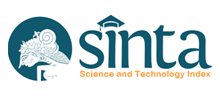Keywords
Parental Mediation Children, Safety Online
Document Type
Article
Abstract
The biggest of internet user is in the productive ages, most of them are children and
teenagers. They are the Internet of Things's (IoT) Generation who have the ability
to adapt of technology because of being born in the high technology era. Children's
internet activities tend to be supported and facilitated by the environment, especially
families. The aim of this research is to find out the digital literacy and medition type
of housewives. The mediation strategy is an effort that is appropriate to the activities
of children and teenager using handset and internet. The survey was conducted on
housewives of Internet Safety Online workshop participant in four districts in DI.
Yogyakarta. Restrictive mediation is applied to housewives at every level of childhood
education from the youngest up to. However, mothers do not apply many types of
mediation in teenagers. Discussion, as a form of active mediation, applied as protecting
effort in the housewives's inability of digital literacy. Co-use mediation and technical
mediation are not overused. Only a small number of housewives accompany children
when using handset or accessing internet.
Pengguna internet terbesar berada di usia produktif, sebagian besar di antara mereka adalah anak dan remaja. Mereka adalah generasi IoT yang memiliki kemampuan beradaptasi dengan teknologi karena terlahir dalam paparan teknologi maju. Aktivitas anak berinternet cenderung didukung dan difasilitasi oleh lingkungan, terutama keluarga. Padahal bahaya mengintai anak ketika berinternet yang kerap diabaikan orang tua. Penelitian ini bertujuan untuk mengetahui tingkat literasi digital dan upaya perlindungan yang diberikan ibu rumah tangga terhadap aktivitas anak dan remaja menggunakan gadget serta berinternet. Survey dilakukan pada ibu rumah tangga peserta pelatihan Internet Safety Online yang diselenggarakan oleh BPPKI Yogyakarta dan Dinas Kominfo Kab. Kulonprogo serta Kab. Gunung Kidul. Hasil survey menunjukkan, ibu rumah tangga memiliki tingkat literasi digital yang baik. Meski demikian, sebagaian besar menerapkan tipe mediasi restriktif dengan membatasi penggunaan waktu. Tidak banyak yang menerapkan tipe mediasi teknik karena merasa tidak mampu mengoperasikan TIK sebaik anaknya.
First Page
197
Last Page
212
Page Range
197-212
Issue
2
Volume
47
Digital Object Identifier (DOI)
10.21831/informasi.v47i2.16548
Source
16548
Recommended Citation
Widiyastuti, I. (2017). TIPE MEDIASI IBU RUMAH TANGGA TERHADAP KESELAMATAN INTERNET ANAK DAN REMAJA. Informasi, 47(2), 197-212. https://doi.org/10.21831/informasi.v47i2.16548
References
Ameliola, S., & Nugraha, H. D. (2013). Perkembangan Media Informasi dan Teknologi Terhadap Anak Dalam Era Globalisasi. Prosiding The 5th International Conference on Indonesian Studies: "Ethnicity and Globaliation", (pp. 362-371). Yogyakarta.
ANTARA. (2017, Februari 2). 4 Langkah Bijak Memantau Aktivitas Internet Anak. Retrieved 2017, from www.tekno.tempo.co.
Clark, L. S. (2011). Parental mediation theory for the digital age. Communication Theory , 21 (4), 323-343.
Dorsey, J. (2016). iGen Tech Disruptio: 2016 National Study on Technology and the Generation after Millennials. The Center for Generational Kinetics.
Fikkers, K. M., Piotrowski, J. T., & Valkenburg, P. M. (2017). A matter of style? Exploring tthe effects of parental mediation styles on early adolescents' media violence exposure and aggression. Computer in Human Behavior , 70, 407-415.
Howe, N., & Nadler, R. (2012). Why Generations Matter: Ten Finding from LifeCourse Research on the Workforce. Life Course Associates.
Kemkominfo. (2014). Riset Kominfo dan UNICEF Mengenai Perilaku Anak dan Remaja Dalam Menggunakan Internet. Retrieved 2017, from www.kominfo.go.id.
Kunandar, A. (2014). MODEL LITERASI MEDIA PADA ANAK DALAM MENCEGAH KONFLIK SOSIAL. Profetik: Jurnal Komunikasi , 7 (1).
Leung, L., & Lee, P. S. (2012). The influences of information literacy, internet addiction and parenting styles on internet risks. New Media & Society , 14 (1), 117-136.
Linggasari, Y. (2015). Ada 1022 Anak Menjadi Korban Kejahatan Online. Retrieved 2017, from CNN Indonesia: https://www.cnnindonesia.com/nasional/20150210171810-20-31101/ada-1022-anak-menjadi-korban-kejahatan-online/
Livingstone, S., & Helsper, E. J. (2008). Parental mediation of children's internet use. ournal of broadcasting & electronic media , 52 (4), 581-599.
Livingstone, S., Haddon, L., Gorzig, A., & Olafsson, K. (2011). Risks and safety on the internet: the perspective of European children: full findings and policy implication from the EU Kids Online survey of 9-16 years olds and their parents in 25 countries. The London Schools of Economics and Political Science.
Nikken, P., & Schols, M. (2015). How and Why Parents Guide the Media Use of Young Children. Jounral of child and familiy studies , 24 (11), 3423-3435.
UNESCO. (2010). Towards Media and Information Literacy Indicators. Bangkok: UNESCO. www.ooma.com
http://kominfo.go.id/content/detail/3834/siaran-pers-no-17pihkominfo
http://tekno.liputan6.com/read/2838968/orang-tua-sering-lalai-bahaya-aktivitas-online-anak-anak

